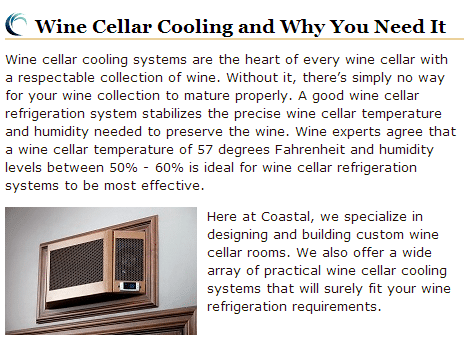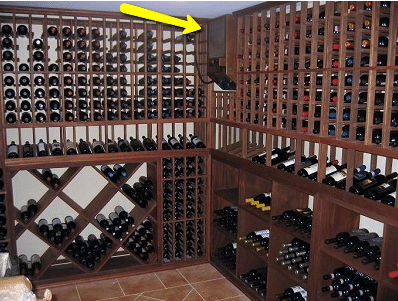Wine Cellar Cooling Question – Can A Wine Cellar Climate Control System Be Added After Construction (A Processed Video Transcription)
Hi, Irene, this is Jerry with Coastal Custom Wine Cellar Climate Control. I wanted to share some information that pertain to your question by email on whether or not wine cellar cooling units are included in wine cellars, or if they can be added after the wine cellar construction is completed and wine racks are installed. The answer to that question is indeed both of those scenarios have taken place, but it’s very important that a wine room be prepared properly before a cooling system is added to the wine room.

The warm side, if you look at this cross section here of a wall, will be the exterior wall or the hot side of the wine cellar; the wine cellar being the cold side or the interior wall here. Within the wall cavity itself, a vapor barrier must be placed on the hot side. This stops warm air and moisture from entering the wine room or the wall cavity, and then ultimately the wine room and stops the moisture.
If there’s no vapor barrier, moisture will creep through the wall cavity through the building materials and ultimately into the wine room where it will come into contact with cool air and thus condensation will form. It will form in the wall cavity itself causing some problems with mold and mildew over time.
In the wine room itself condensation could actually form on the bottles, in the corners, on the paint, on the door hardware, and on any glass structures that are in there like a window maybe. This is very, very important.
The insulation factor that you see here in the middle, which is on the cold side of the vapor barrier, helps retain or keep the cool air in the wine room, as any typical insulation to a home or a business would. I think if you read through this, you will find different ways that these wall cavities can be prepared with vapor barriers and insulations.
There’s actually two ways. There’s the old school way where a 6 mil or 8 mil plastic sheeting is used; and there’s also a more modern technology, it’s a blow in foam expanding insulation that a contractor would actually blow into the wall cavity. It’ll expand, dry, and it is a far more accurate or better way, I should say, although it is a little pricier.
I’m here for any of your questions regarding wine cellar cooling Los 
People in the northeast or in any cold climate, and especially if they are in basements or below ground level, it’s typically very cool and appropriate temperatures, so wine cellar climate control units may never actually be added. This is referred to as a passive cellar or it is either naturally cooled or the collector has decided not to cool the wine room for whatever reason.
Just to summarize, it is very important that a wine room be prepared properly for refrigeration. Even if you don’t add the wine cellar cooling unit during the course of wine cellar construction, it’s very important that the wine room itself be prepped properly, so that later down the road the client decides to add a cooling unit, he doesn’t have to tear out the walls and start from square one.
Again, if you have any questions, you may call or send an email. Cheers!
